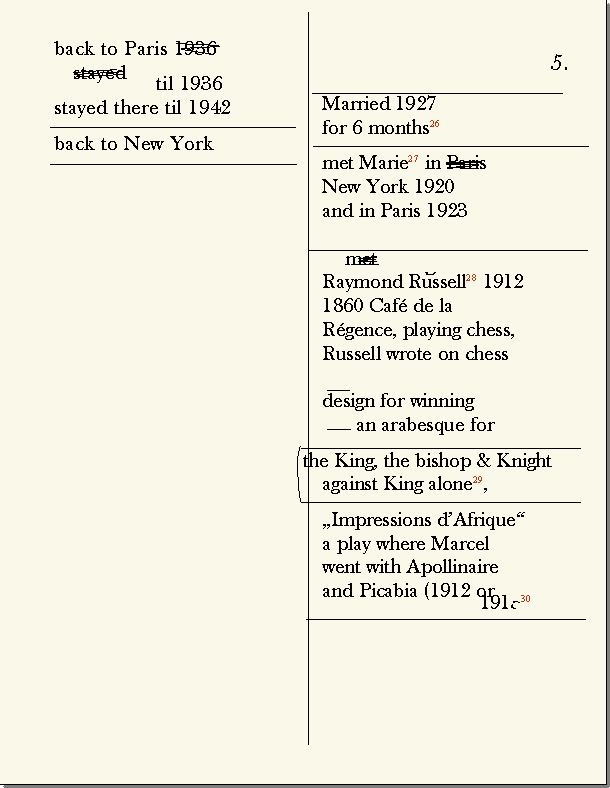19. September 19, 1918 to June 22, 1919. See: J.Gough-Cooper and J.Caumont, ibid. 20. August 9, 1919 to December 27, 1919, ibid. 21. The Large Glass, conceived in Germany and France, was completed in New York. 22. »Je vais m´occuper d´une exposition Brancusi en Novembre. Et lui même arrive le 15 Septembre à N.Y. Vous le rencontrerez, si vous ne l´avez déja, et l´aimerez«. »I´ll be taking care of a Brancusi exhibition in November and he will also be arriving 15th September in N.Y. You will meet him if you haven’t already, and will like him«. Marcel Duchamp to Ettie Stettheimer, September 23, 1926, in Affectionately Marcel Duchamp, edited by Francis M. Naumann and Hector Obalk, Amsterdam 2000, pp. 155-156. 23. This asterisk does not refer to anything in the text. In 1927 Duchamp moved to 11, rue Larrey where he remained until 1933. 24. In 1933 Duchamp returned to New York to set up a show of Brancusi at the Brummer Gallery (November 17, 1933 to January 1, 1934). After that show Duchamp went back to Europe and visited New York only occasionally. In 1942 he finally settled down in New York. For one year starting from October 2, 1942 Duchamp rented a room with a bath in Kiesler´s penthouse at 56 Seventh Avenue. See Steffi Kiesler Calendar from 1942, Archive of the Frederick Kiesler Center, Vienna. 25. May 25, 1936 to September 2, 1936. Katherine Dreier covered the expenses to repair the Large Glass which was broken accidentally in 1926 after its first installation at the Brooklyn Museum. The damage was discovered some years later when Katherine Dreier opened the crate in which the glass panels have been stored. 26. As reported in most literature on Duchamp, he married Lydiae Sarazin-Levassor (probably because of her valuable dowry) and obtained the divorce from her a few months later. 27. Duchamp had two Marys in his life: Mary Reynolds and Maria Martins. As Duchamp met Maria Martins only in the 1940s, this »Marie« is probably identifiable with Mary Reynolds (1891-1950). Mary Reynolds was one of Marcel Duchamp´s lifelong companions and she was also a friend of the Kieslers. It is most likely that Kiesler only jutted down her first name since both him and Duchamp knew her quite well. C.Tomkins reports that Duchamp introduced Mary Reynolds to the writer Henri-Pierre Roché in 1924, even though »Duchamp´s liaison with her had apparently begun several months earlier« see: C.Tomkins, ibid. p. 257. 28. The name »Roussel« is spelled wrong in the original. Raymond Roussel (1877-1933), author of Impression d´Afrique. Duchamp referred in an interview with James Johnson Sweeney that this text was the main source of inspiration for La mariée mise à nu par ses célibataires, même. Duchamp met Roussel at the Café de la Régence, a famous coffee house in Paris where chess players met for tournaments and chess lessons. Kiesler refers to Roussel in the front and in the back page of the triptych: »R.Roussel/né 1877/artiste-inventeur/du mirage de la cédille aux échecs«. Nearly the same words are used for the description of Marcel Duchamp: »Marcel D./né 1877/artiste-inventeur/du mirage des réseaux circonflexes en peinture«. 29. This phrase describes the Formule Raymond Roussel, a particular chess strategy created by Roussel. See: J.Gough-Cooper and J.Caumont, »Kiesler und Die Braut von ihren Junggesellen nackt entlößt, sogar«, in: D.Bogner a.o., Friedrich Kiesler 1890-1965, Wien 1988, pp.287-296. The same text was published in English in Y.Safran a.o. Frederick Kiesler 1890-1965, London 1989, pp.62-68 30. The chronology of the meetings between Duchamp and Apollinaire is not definitive yet. While d´Harnoncourt reports that they met for the play Impression d´Afrique in May 1912, Tomkins dates their first meeting to June 1912. Duchamp often declared that he met Apollinaire at the show of the Section d´Or, as also reported in this manuscript. Furthermore Duchamp, in an interview with Pierre Cabanne, confirmed that he met Apollinaire in 1911 at Impression d´Afrique including also Picabia and Gabrielle Buffet in the group. See: P.Cabanne, Gespräche mit Marcel Duchamp, Köln 1972, p.41. |
|||||||||||||
